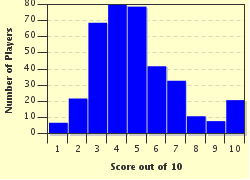Quiz Answer Key and Fun Facts
1. The thyroid is an endocrine gland, and is situated at the base of the neck. Upon which cartilage is it situated?
2. Which of these is not usually part of the adult thyroid gland, but can sometimes appear as a rare anatomical variation?
3. Where in the embryo does the thyroid gland first develop?
4. The bulk of the thyroid gland is made up of follicles, which contain thyroid hormones attached to a protein named thyroglobulin. From which amino acid are thyroid hormones derived?
5. Which hormone do parafollicular cells release?
6. Which of these is NOT an action of thyroid hormones?
7. Hyperthyroidism occurs when the body produces too much of the thyroid hormones. What symptom gives its name to exophthalmic goitre?
8. Cretinism, a condition that causes stunted physical growth and mental retardation, can occur in a baby if the mother does not have adequate iodine in her diet.
9. When does postpartum thyroiditis, which involves both hyper- and hypothyroidism, occur?
10. The thyroid gland is supplied by two arteries, the superior thyroid and inferior thyroid arteries, which run into the apex and base of each lobe respectively. From which major blood vessel does the superior thyroid artery arise?
Source: Author
reeshy
This quiz was reviewed by FunTrivia editor
crisw before going online.
Any errors found in FunTrivia content are routinely corrected through our feedback system.

